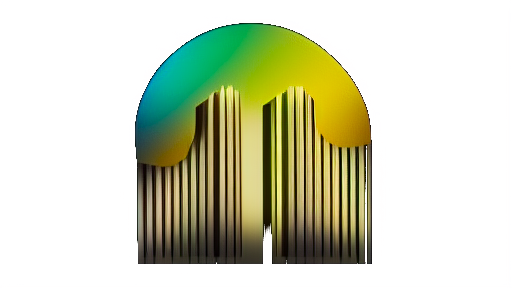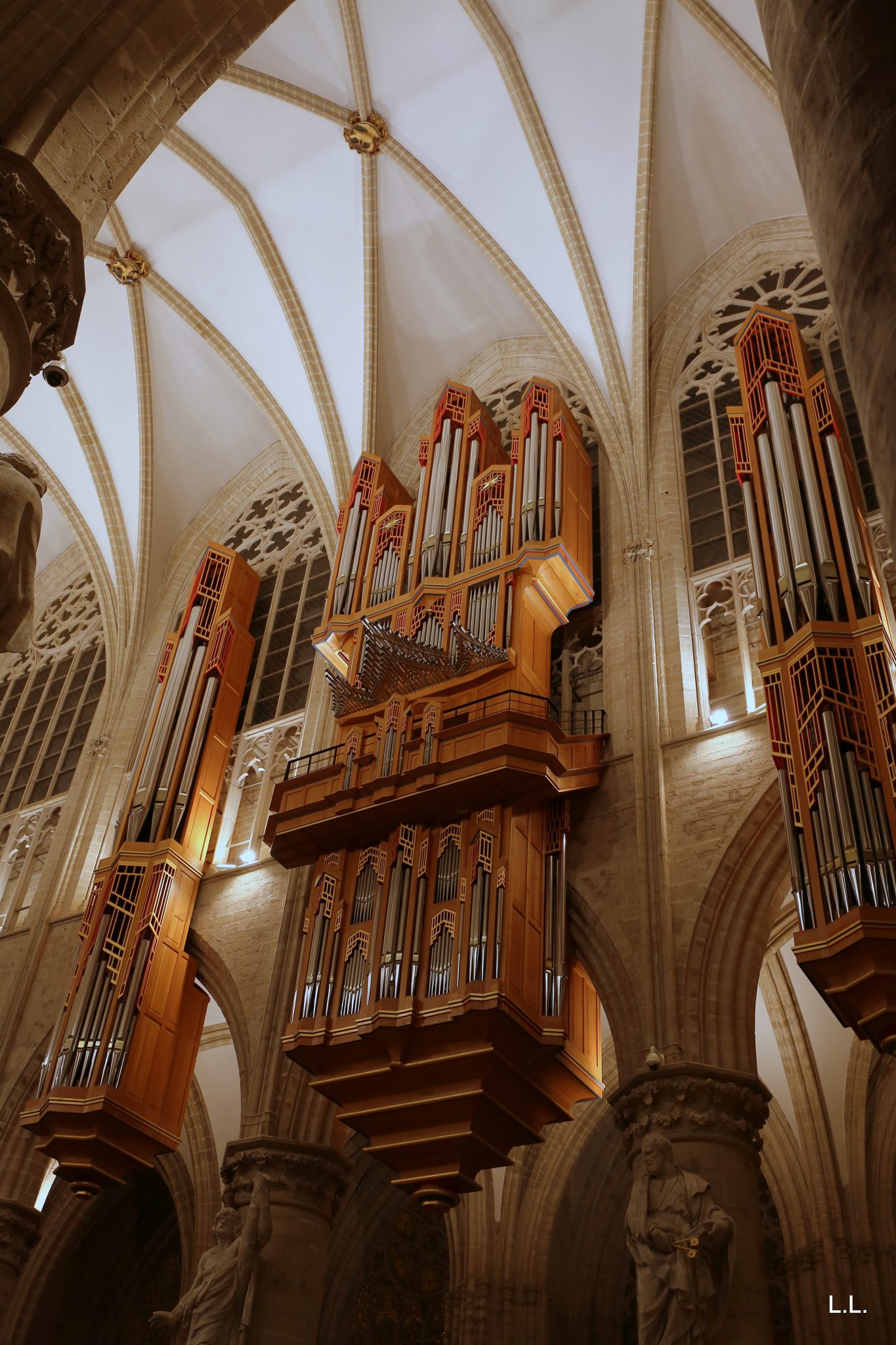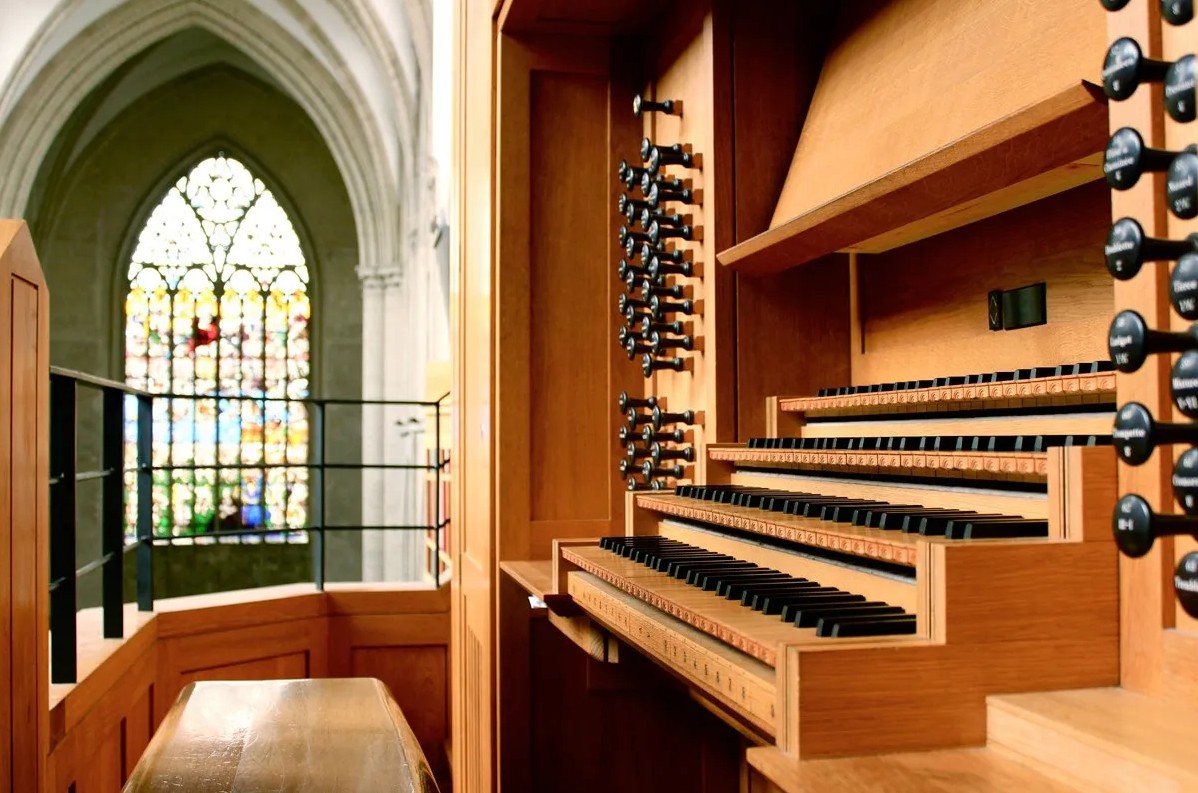Brussels, Cathédrale Saint-Michel et Sainte-Gudule
| Builder | G. Grenzing |
|---|---|
| Year | ca. 2000 |
| Period/Style | Neo-Baroque |
| Stops | 63 |
| Keyboards | 4+P |
| Keyaction | tracker/mechanical |
It is during the spring of the year 2000 that the new organ was hooked on the North wall of the Cathedral: this instrument has been built by Gerhard Grenzing and his team in the workshop of El Papiol (Barcelona). The organ is made of three parts: the central one with the console of four keyboards and pedal, and 63 stops, and the two pedal towers. The organ is located in a swallow’s nest, and the weight is about thirty tons. This organ location is one of the best in this big acoustic as the sound is reflected by the walls in front and the vault.
This is one of the oldest location of organ in big churches and cathedrals. Other ones remains in France or Germany like in Metz, Chartres, Köln.
The style of the new main organ of the Cathedral is mostly baroque, but suits also the neo-classical repertoire as the modern one. The deep and rich sonority of the plenum (25 ranks) is typical of the north european countries. This plenum is colored by flutes and mutations stops, and also a great variety of reeds. Some of them are from Spain, the horizontal trumpets (chamadas). An electronic combiner is used for the task of the registration.
Gerhard Grenzing builds organs in a traditional way : the tracker is mechanical for the keyboards and the pedal, as it was done in former times, as for the windchest with stops. Organists do appreciate the vivacity of the the mechanical traction of the organs of Gerhard Grenzing. Same for the pipes, which are also built and tuned in the traditional way.
Noble material is used for the building as well as materials of our time, like marine plywood for the windchest, so they are more solid and they can resist longer. The pedal transmission is made by metallic cables.
To stand up, the organ is supported by a metallic corset, which is hidden by wood panels.
This metallic structure, combined with the beam structure is very particular of this organ: without it, this project would have not been possible. Organists have a great feeling of solidity.
This is one of the oldest location of organ in big churches and cathedrals. Other ones remains in France or Germany like in Metz, Chartres, Köln.
The style of the new main organ of the Cathedral is mostly baroque, but suits also the neo-classical repertoire as the modern one. The deep and rich sonority of the plenum (25 ranks) is typical of the north european countries. This plenum is colored by flutes and mutations stops, and also a great variety of reeds. Some of them are from Spain, the horizontal trumpets (chamadas). An electronic combiner is used for the task of the registration.
Gerhard Grenzing builds organs in a traditional way : the tracker is mechanical for the keyboards and the pedal, as it was done in former times, as for the windchest with stops. Organists do appreciate the vivacity of the the mechanical traction of the organs of Gerhard Grenzing. Same for the pipes, which are also built and tuned in the traditional way.
Noble material is used for the building as well as materials of our time, like marine plywood for the windchest, so they are more solid and they can resist longer. The pedal transmission is made by metallic cables.
To stand up, the organ is supported by a metallic corset, which is hidden by wood panels.
This metallic structure, combined with the beam structure is very particular of this organ: without it, this project would have not been possible. Organists have a great feeling of solidity.
| I. Positif | II. Grand-Orgue | III. Récit expressif | IV. Solo expressif | Pédalier |
|---|---|---|---|---|
| Bourdon 16 | Montre 16 | Salicional 8 | Bourdon 8 | Principal 16 |
| Montre 8 | Montre 8 | Gambe 8 | Viola 8 | Soubasse 16 |
| Bourdon 8 | Flûte harmonique 8 | Voix céleste 8 | Voce humana 8 | Grosse Quinte 10 2/3 |
| Quintadeen 8 | Bourdon à cheminée 8 | Cor de nuit 8 | Prestant 4 | Flûte 8 |
| Prestant 4 | Viole de gambe 8 | Prestant 4 | Flageolet 2 | Basse 8 |
| Flûte à cheminée 4 | Prestant 4 | Flûte octaviante 4 | Larigot 1 1/3 | Gros Nasard 5 1/3 |
| Nasard 2 2/3 | Flûte conique 4 | Nasard 2 2/3 | Cornet V | Prestant 4 |
| Doublette 2 | Quinte 2 2/3 | Quarte 2 | Trompeta batalla 8 | Fourniture V |
| Tierce 1 3/5 | Doublette 2 | Sifflet 1 | Bajoncillo-Tr. magna 4-16 | Contre-posaune 32 |
| Larigot 1 1/3 | Mixture IV | Plein-jeu IV-V | Voix humaine 8 | Posaune 16 |
| Mixture V-VI | Cymbale III-IV | Tiercelette III | Douçaine 8 | Trompette 8 |
| Trompette 8 | Trompette 16 | Basson 16 | Clairon 4 | |
| Cromorne 8 | Trompette 8 | Trompette harmonique 8 | ||
| Hautbois 8 |
No Video/Audio samples available.
https://www.brusselscityoforgans.org/en-gb/annuaire/orgues/cath%C3%A9drale
http://www.orgues.irisnet.be/fr/DetailOrgue/17/app.rvb
http://www.orgues.irisnet.be/fr/DetailOrgue/17/app.rvb
 Pipe Organ Map
Pipe Organ Map
